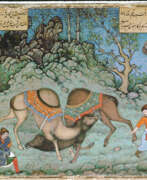Painters Mughal Empire


Abd al-Samad (also known as Hodja Abdus Samad, Abd al-Samad Shirazi) was a prominent Persian miniaturist and an influential figure in the development of the Mughal school of miniature painting. Born in Shiraz, Iran, around the early 16th century, he was initially trained in the Safavid style under Shah Tahmasp in Tabriz. His career took a significant turn when he moved to India, where he joined the court of the Mughal emperor Humayun and later served his successor, Akbar.
Abd al-Samad's impact on Mughal art was profound. He co-directed a rapidly expanding imperial atelier and was instrumental in the production of the Hamzanama, an ambitious project that consisted of 1,400 large-scale paintings. His administrative prowess was recognized by Akbar who appointed him to several high-ranking positions, including the director of the royal mint and the governor of Multan. Despite his administrative duties, Abd al-Samad continued to influence the artistic direction of the Mughal court through his teaching and his own works, which remained loyal to the Persian artistic tradition.
Several of Abd al-Samad's works are preserved in major museums, including a portrait of Akbar, which reflects his mastery and his stylistic adherence to Persian aesthetics. His works are noted for their detailed execution and the integration of Persian and Indian elements, a testament to his role in shaping the Mughal artistic heritage.
For more on Abd al-Samad's life and works, you can visit the Metropolitan Museum of Art's collection.
If you are interested in updates on exhibitions and sales related to Abd al-Samad's works, consider signing up for relevant notifications. This will keep you informed about new insights and opportunities to engage with his art at auctions and galleries.